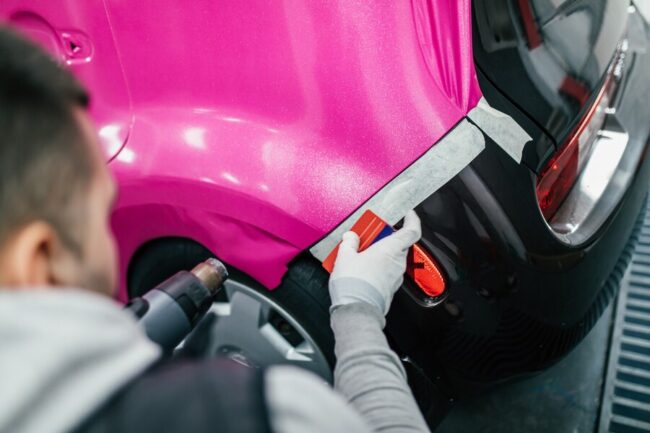Your car’s interior is more than just a functional space—it reflects your style and personality. When enhancing the aesthetics of your car’s interior, choosing the right non-reflective tint can make a significant difference. Non-reflective tint adds a sleek and stylish look to your car and offers practical benefits like glare reduction, UV protection, and heat rejection.
In this blog post, we’ll explore the key factors to consider when selecting non-reflective tint for your car’s interior. From understanding different tint shades and transparency levels to exploring the types of non-reflective tint available, we’ll guide you through choosing the perfect tint to complement your car’s interior design. Whether aiming for a bold statement or a subtle enhancement, the right non-reflective tint can elevate your car’s interior aesthetics while providing comfort and protection.
Understanding Non-Reflective Tint
Non-reflective tint is a window film that enhances a car’s interior aesthetics while providing various functional benefits. Unlike reflective tint, which can create a mirrored effect, non-reflective tint reduces glare without compromising visibility. It also offers UV protection, shielding passengers and the car’s interior from harmful sun rays.
Additionally, non-reflective tint provides heat rejection, keeping the interior cooler and more comfortable. This type of tint is available in different shades and levels of transparency, allowing car owners to customize their vehicle’s look while enjoying the practical advantages of window tinting.
Benefits Of Non-Reflective Tint
- Glare Reduction: Non-reflective tint helps reduce glare from sunlight and headlights, improving visibility and comfort while driving.
- UV Protection: It blocks harmful UV rays from entering the car, protecting your skin and interior from sun damage and fading.
- Heat Rejection: Non-reflective tint can significantly reduce the heat entering your car, keeping the interior cooler and more comfortable, especially in hot climates.
- Privacy: It provides privacy by making it difficult for outsiders to see inside the car, enhancing security and privacy for you and your belongings.
- Enhanced Aesthetics: Non-reflective tints can enhance the overall look of your car’s interior, giving it a sleek and modern appearance.
- Safety: It can help prevent the shattering of glass in case of an accident by holding the glass together, providing an added layer of safety.
- Reduction of Interior Fading: By blocking UV rays, non-reflective tints can help preserve the interior of your car, including upholstery, dashboard, and electronics, reducing fading and deterioration over time.
Factors To Consider
- Tint Shade: The shade of tint you choose can significantly impact the look and feel of your car’s interior. Consider the interior colour scheme and the level of visibility you prefer. Darker tints offer more privacy but may reduce visibility at night.
- Tint Transparency: Transparency refers to how much light can pass through the tint. Choose a level of transparency that balances your desired level of privacy with visibility. Too dark a tint can hinder visibility, especially at night or in low-light conditions.
- Legal Regulations: Check your local laws and regulations regarding tint darkness and reflectivity limits. Different states and countries have specific rules regarding how dark you can tint your windows, and violating these regulations can result in fines or penalties.
- Type of Non-Reflective Tint: Consider the non-reflective tint that best suits your needs. Ceramic tint offers superior heat rejection and UV protection with minimal interference to electronic signals. Carbon tint provides good heat rejection, UV protection, and a matte finish that enhances interior aesthetics. Dyed tint enhances colour and provides a sleek look but may not offer as much heat rejection.
- Installation Process: Proper installation is crucial for the effectiveness and longevity of your tint. Ensure a professional installs the tint to avoid issues such as bubbling, peeling, or improper fit. Professional installation also ensures compliance with legal regulations.
- Maintenance and Care: Consider the maintenance requirements of the tint you choose. Some tints may require special care to maintain their appearance and functionality. Follow the manufacturer’s guidelines for cleaning and maintenance to ensure the tint lasts longer and looks its best.
Types Of Non-Reflective Tint
- Ceramic Tint:
-
-
- Benefits: Superior heat rejection, UV protection, and glare reduction.
- Characteristics: Contains ceramic particles that block heat and UV rays without interfering with electronic signals (e.g., GPS, radio).
- Aesthetics: Offers a clear and non-reflective appearance, preserving the original look of the car’s windows.
-
- Carbon Tint:
-
-
- Benefits: Good heat rejection, UV protection, and glare reduction.
- Characteristics: Contains carbon particles that absorb heat and block UV rays, providing a matte finish that enhances interior aesthetics.
- Aesthetics: It creates a sleek and stylish appearance, especially with its matte finish.
-
- Dyed Tint:
-
- Benefits: Color enhancement and sleek appearance.
- Characteristics: It uses a dye to create the desired tint colour, offering some heat and UV protection, but it is less effective than ceramic or carbon tints.
- Aesthetics: Provides a range of tint colours and can enhance the overall look of the car’s interior, but may not offer as much heat rejection as other types of tint.
Installation Process
- Preparation:
-
-
- Clean the inside of the car windows thoroughly to remove any dirt, dust, or residue.
- Measure and cut the tint film to the appropriate size for each window, leaving a small margin around the edges for trimming later.
-
- Application of Tint:
-
-
- Spray a light mist of soapy water onto the inside surface of the window.
- Peel off the protective backing from the tint film and carefully place it onto the wet window surface, ensuring it aligns with the edges of the window.
- Smooth any air bubbles or wrinkles using a squeegee, starting from the centre and working towards the edges.
- Use a heat gun or hairdryer to gently heat the tint film, which helps it conform to the curved shape of the window and ensures a smooth, wrinkle-free finish.
-
- Trimming:
-
-
- Once the tint film is applied and smoothed out, use a sharp utility knife to trim off the excess film around the edges of the window.
- Be careful not to cut too close to the edge of the glass to avoid damaging the tint or the window seal.
-
- Final Steps:
-
-
- Use a clean, lint-free cloth to remove any remaining moisture or soapy residue from the window.
- Inspect the tint for any imperfections or areas that may need touch-ups.
- Allow the tint to dry completely before rolling down the windows or exposing them to moisture.
-
- Professional Installation:
-
- While DIY installation is possible, a non-reflective tint is often recommended by a professional to ensure proper fit, adherence to legal regulations, and a high-quality finish.
- Professionals have the expertise and tools to handle the installation process efficiently and effectively, reducing the risk of errors or damage to the tint film.
 Importance Of Professional Installation
Importance Of Professional Installation
- Expertise: Professional installers have the knowledge and experience to apply the tint properly, ensuring a smooth and seamless finish without bubbles, creases, or imperfections.
- Legal Compliance: They are familiar with local laws and regulations regarding tint darkness and reflectivity limits, ensuring that the tint meets these requirements to avoid fines or legal issues.
- Quality Materials: Professionals use durable tint films that provide adequate UV protection and maintain their colour and clarity over time.
- Warranty: Many professional installers offer warranties on their artistry and the tint itself, providing peace of mind and recourse in case of any issues with the installation or the tint film.
- Time and Convenience: Professional installation saves you time and hassle compared to DIY methods, as they have the tools and expertise to complete the job efficiently and effectively.
- Aesthetic Appeal: Proper installation enhances the overall aesthetic appeal of the car, ensuring that the tint complements the interior design and exterior appearance without any visible flaws.
Maintenance And Care
Proper maintenance is essential to ensure that your non-reflective tint remains in top condition and continues to enhance the aesthetics of your car’s interior. Here are some tips to help you care for your tint:
- Gentle Cleaning: Use a soft, non-abrasive cloth or microfiber towel to clean the tinted windows. Avoid harsh chemicals or abrasive cleaners, which can damage the tint film.
- Mild Soap Solution: If needed, use a mild soap solution (diluted with water) to clean the tinted windows. Rinse thoroughly and dry with a soft cloth to prevent water spots.
- Avoid Sharp Objects: Be cautious when loading or unloading items from your car to avoid scratching the tint film. Sharp objects like keys or metal accessories can cause damage.
- Regular Inspection: Inspect the tint for any signs of peeling, bubbling, or discolouration. If you notice any issues, consult a professional tint installer for advice on repair or replacement.
- Avoid Abrasive Materials: When cleaning your car’s interior, avoid using abrasive materials or rough brushes near the tinted windows, as they can scratch the film.
- Protect from Sun Damage: Park your car in shaded areas whenever possible to minimize prolonged exposure to direct sunlight, which can degrade the tint film over time.
By following these maintenance tips, you can prolong the life of your non-reflective tint and keep your car’s interior looking stylish and well-protected.
Conclusion
Choosing the right non-reflective tint for your car is an art that balances aesthetics, functionality, and personal preference. By considering the factors discussed in this guide such as tint darkness, tint material, and tint finish—you can enhance your car’s interior in style while enjoying practical benefits like UV protection, heat reduction, and glare reduction.
When selecting your non-reflective tint, remember to comply with local regulations to ensure your tint meets legal requirements. Additionally, opt for professional installation to achieve a flawless finish that looks great and lasts longer.
With the right non-reflective tint, you can transform your car’s interior into a comfortable, stylish, and protected space that reflects your unique taste and personality. So, whether you prefer a sleek, understated look or want to make a bold statement, choose wisely to enjoy the perfect blend of aesthetics and functionality for your car.




